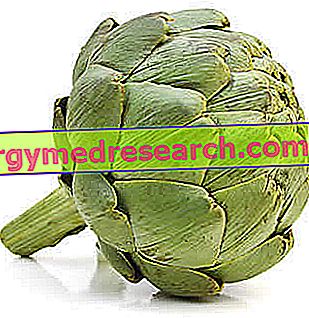Generality
The artichoke is a food of vegetable origin that belongs to the seventh food group; in the kitchen we eat the flower (see recipes with artichokes), while the leaves and roots find other uses, especially in the phytotherapeutic field and in the liquor industry.

The Laon artichoke takes its name from the homonymous French region; the edible portion consists of the pulp of the external scales of the flower (bracts), the receptacle and the stem.
The culinary use of the Laon artichoke concerns: appetizers, side dishes, sauces and dishes.
Nutritional Features
Like all artichokes, Laon's is also known for its nutritional properties and is suitable for any diet.
It is low in calories, predominantly protein, has many soluble fibers and contains several mineral salts, vitamins and other beneficial molecules.
Thanks to its antioxidant polyphenol content, it is widely used in nutritional therapy against metabolic diseases; in particular: hyperglycemia and type 2 diabetes mellitus, hypertriglyceridemia and hypercholesterolemia.
Inulin (soluble fiber) helps to fight constipation, increases the perception of gastric satiety, modulates intestinal absorption (lowering the glycemic index and reducing lipid absorption) and acts as a probiotic improving the intestinal bacterial flora. This makes the artichoke very useful in the diet of the obese, diabetic, hypercholesterolemic and hypertriglyceridemic.
The antioxidant polyphenol typical of artichokes is cynarin, a molecule known for its marked and multiple health functions. In particular, this compound seems to exert a protective and purifying role on the liver, improves cholesterolemia and stimulates bile flow.
NB : Thanks to the concentration of cynarin, the infusion of artichoke leaves of Laon has marked cholagogic and choleretic (digestive) functions.
As regards saline and vitamin nutrients, the quantities of iron, calcium, potassium and ascorbic acid (vit C) stand out.
The Laon artichoke lends itself to vegetarian, vegan, lactose and gluten intolerance (celiac disease).
The average portion varies according to the recipe. Assuming to use it as a side dish, considering that the edible portion is only 34%, the amount of artichoke for an adult could be around 400-800g (140-280g of edible matter).
Laon Artichoke and Weight Loss
The Laon artichoke was recently used in the production of dietary supplements for slimming purposes.
The reason for this choice is not clear; according to the slogan on the product label, this extract should act "destroying" the fat cells.
First of all, the destruction of adipocytes is not a completely desirable effect (the adipose one is a tissue with very important endocrine functions). Moreover, the Laon artichoke does not have a chemical composition such as to suggest any lipolytic effect.
The companies offer the Laon artichoke in the form of dry extract in capsules (cynarin, other polyphenols and inulin), to be taken daily at meals.
Ultimately, Laon-based artichoke food supplements have no slimming effect. They do not destroy adipocytes, they do not mobilize fats from adipose tissue, nor do they promote cellular lipolysis. In this context, it is a product to be avoided.
The only useful use could be as a source of polyphenols and inulin for:
- Reduce oxidative stress.
- Promote the restoration of altered metabolic parameters (cholesterolemia, glycaemia and triglyceridemia).
- Promote liver purification.
NB : all the effects listed can only be obtained in conjunction with a proper diet and regular motor activity.
Brief notes on Botany
The Laon artichoke belongs to the group of raw green artichokes, to the genus Cynara, to the scolymus species, to the viridis variety and to the Laon sub-variety.
It is cultivated above all in the northern areas, where the climate is more rigid.
It has a good yield and, in particularly fertile soils, the flower reaches considerable dimensions (basal diameter of almost 15cm).
The bracts are not very open, not too long, pointed but dull and of a bright green color. They contain most of the edible portion. This pulp is fleshy, not too soft and attached to the non-digestible fibrous lamina.



